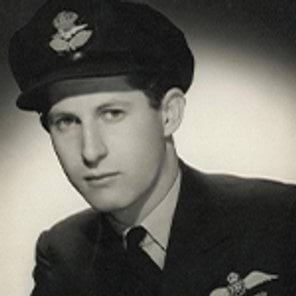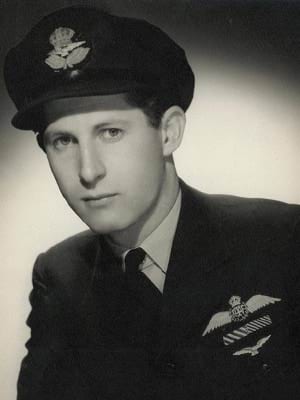
- Conflict:
- Second World War (1939-45)
- Service:
- Air Force
I feel privileged to have known Wing Commander Peter Isaacson AM DFC AFC DFM. I first met him over a decade ago while I was still serving in the RAAF and from the start I was struck by his philosophy ‘when in doubt do the courageous thing’; or more simply, do the right thing.
Peter served his country continuously since being called to commence pilot training in December 1940. Of course he always retained his cheeky sense of humour; when I asked him why he joined the RAAF he said he was walking down Bourke Street and saw a mannequin in a blue RAAF uniform in the Myers window and wanted to look just like that!
After flying training in Australia and Canada, by 1942 he was at an operational training unit in England. Somewhat surprisingly for someone still at a training unit but indicative of the demands of the time, he took part in several thousand bomber raids. He then joined the well-known 460 Squadron RAAF, formed the crew that would largely remain with him throughout the war and flew initially twin-engined Wellingtons, briefly the Halifax and ultimately the Lancaster.
By November 1942, he had been awarded the Distinguished Flying Medal with the citation reading in part ‘fine offensive spirit, great determination, an ideal leader’; these were characteristics that were to be apparent throughout his life. In early 1943, having almost completed the required 30 operational sorties, Peter was asked to join the newly formed Pathfinder Force. The Pathfinder Force was formed by another Australian, Air Commodore Don Bennett and was to consist of experienced aircrew, all volunteers, with more sophisticated navigation equipment to lead the bomber force and mark the target. The challenges of the task were recognised by a reduction in the number of operational sorties required (an additional 15 added to the 30 already completed) and the award of the Pathfinder badge: a golden kite hawk. Peter and all but one of his crew volunteered.
Peter joined 156 Squadron RAF and he and his crew consequently became what are known as Odd Bods: Royal Australian Air Force members serving in a Royal Air Force squadron. Commissioned as a Pilot Officer and wearing the coveted Pathfinder Badge, by March 1943 Peter had been awarded the Distinguished Flying Cross with the citation again reading in part ‘coolness, resolution, skilful airmanship, an outstanding captain of aircraft’.
In May 1943, the Royal Air Force was looking to prove a route for their Tiger Force commitment to the war in the Pacific and Australia wanted a Lancaster to assist in selling war bonds. On 22 May 1943, after 45 operational sorties, Peter (now a Flight Lieutenant) and his crew left in Q for Queenie VI on this, the first flight from England across the Atlantic, the United States and the Pacific to Australia—and the longest flight by a Lancaster.
It is worth contemplating that this flight was only 15 years after Sir Charles Kingsford Smith and the Southern Cross flew the first trans-Pacific flight from the United States to Australia in 1928, was just 12 months after Peter’s first operational flight—and he was only 22 years old. For this landmark flight he was awarded the Air Force Cross.
Of course Peter was always more of a fighter pilot than a bomber pilot which probably accounts in part for his well-known feat of flying Q for Queenie under the Sydney Harbour Bridge.
Transferring to the Reserves after the war, Peter became Commandant of the Victorian Air Training Corps 1950–68. Peter would be pleased to know that his recommendation from that period has come to fruition with the Australian Air Force Cadets now offered both gliding and powered flight. He was also Commanding Officer of No 21 (City of Melbourne) Squadron from 1961 until retiring as a Wing Commander in 1969.
As a Shrine Trustee, Chairman and Life Governor, Peter gave over sixty years of continuous service to the Shrine of Remembrance, the veteran community and the people of Victoria.
He was first appointed as a Trustee by the Governor in Council in 1956 and served until 2000, becoming the longest serving Trustee. As a Trustee he was appointed the Deputy Chairman for five years and then appointed Chairman of Trustees from 1983 to 2000.
As Chairman of Trustees, Peter oversaw a most comprehensive period of restoration works for the Shrine. During the same period, Peter together with the Trustees was responsible for pioneering the vision of commemoration through education and learning. This vision culminated in the development of the Shrine Undercroft and ultimately the dedication of the Galleries of Remembrance on 11 November 2014, the most significant addition to the Shrine since its dedication 80 years earlier.
In 2000, Peter was appointed a Life Governor and continued actively in that role, regularly supporting ceremonial events and taking part in public programs at the Shrine of Remembrance. We were most fortunate that he attended the Shrine Remembrance Dinner in November last year where he received a Letter of Appreciation from the Honourable Linda Dessau AC, Governor of Victoria.
Peter was the last surviving member of the crew of Q for Queenie and the longest serving member of the Shrine Family; we honour and will remember him.
Updated
